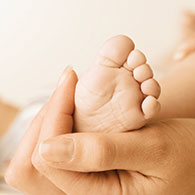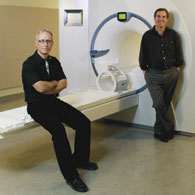Insights (Page 3)
Baby Boon

McGill researchers made some reproductive history this summer when they announced the birth of the first baby born from eggs matured and frozen in the lab, an achievement that could give women with cancer or ovarian disease fresh hope for motherhood.
The landmark research effort, headed by the McGill Reproductive Centre's Hananel Holzer, involved 20 patients with polycystic ovary syndrome (PCOS), whose immature eggs were matured and frozen at the centre, located at the McGill University Health Centre's Royal Victoria Hospital. PCOS is a hormone disorder that affects one in 10 women and is a leading cause of infertility.
"McGill is a pioneer in both the freezing and individual in-vitro maturation of eggs and this is the first time these two technologies have been successfully combined," notes Holzer, an assistant professor of obstetrics and gynecology.
Holzer suggests this new technique might also be appropriate for some cancer patients who wish to preserve their fertility, but don't have time in the menstrual cycle to produce mature eggs before beginning cancer treatment.
An Inside Look at Young Brains

MNI researchers Bruce Pike (left) and Alan Evans contributed to the MRI Study of Normal Brain Development
Allen McInnis
It's taken six years, hundreds of volunteers, thousands of complicated images and millions of dollars. The result, according to Dr. Alan Evans of McGill's Montreal Neurological Institute (MNI), is a vital tool for researchers: the first-ever online database offering detailed information on how young brains blossom over time.
The MRI Study of Normal Brain Development, an effort spearheaded by the U.S. National Institutes of Health (NIH), involved several research centres and children's hospitals across North America in a bid to better understand how the brain typically develops in children and adolescents. Scores of youngsters had their heads examined with magnetic resonance imaging technology.
"We have massive amounts of information at our disposal that we never had before, which can only lead to better science and new discoveries," says Evans, a biomedical engineering professor who led the MNI team that created the database.
The NIH selected Evans and his MNI team to oversee the coordination of the data being assembled during the mammoth study. Working with six pediatric centres in the U.S., the MNI compiled thousands of images of subjects ranging in age from newborn to 18 years. These were collected over a period of years to chart the development of a healthy brain. Along with the images, the database holds the results of intelligence, neuropsychological, verbal, non-verbal and behavioural tests. All of the data collection, quality control and software design were done at the MNI.
Taken together, the database serves as a globally available "Patient 0" for brain researchers, a control against which they can compare their own data.
"This project is already making waves in the scientific community, as we no longer have to search for suitable control subjects and then take the time to scan and process data before analyzing it," says Evans. "Instead, the control data is at our fingertips, 24 hours a day, seven days a week."
Evans explains that the high quality of the images, combined with the breadth of data available online, means that the MNI database can be used by anyone from autism researchers in Japan to psychologists charting intellectual development in Mexican youth.
"The way science is being done is increasingly collaborative on a global scale. It is exciting to see this database being used for so many studies."


